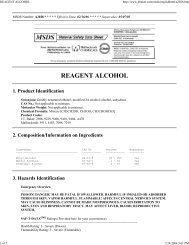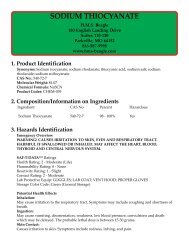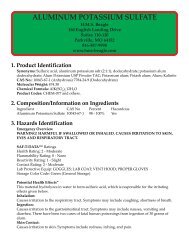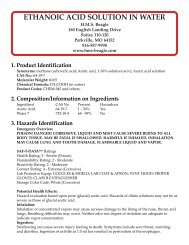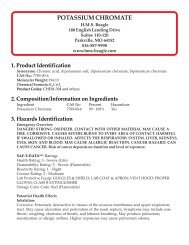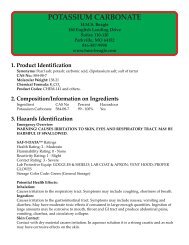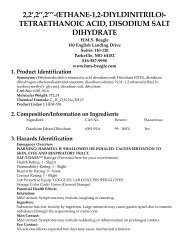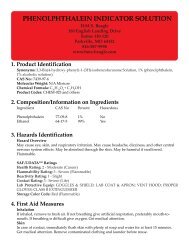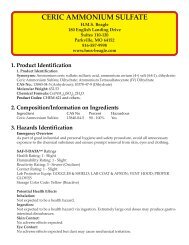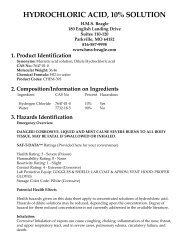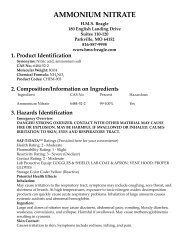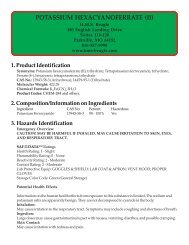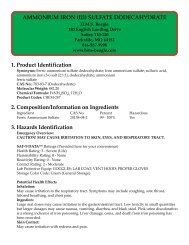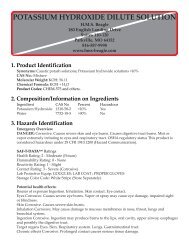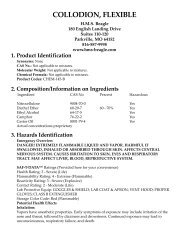Dipotassium Persulfate - HMS Beagle
Dipotassium Persulfate - HMS Beagle
Dipotassium Persulfate - HMS Beagle
Create successful ePaper yourself
Turn your PDF publications into a flip-book with our unique Google optimized e-Paper software.
POTASSIUM PERSULFATE<br />
H.M.S. <strong>Beagle</strong><br />
180 English Landing Drive<br />
Suites 110-120<br />
Parkville, MO 64152<br />
816-587-9998<br />
www.hms-beagle.com<br />
1. Product Identification<br />
Synonyms: Peroxydisulfuric acid, dipotassium salt; dipotassium persulfate; Potassium<br />
Peroxydisulfate; Potassium peroxodisulfate<br />
CAS No.: 7727-21-1<br />
Molecular Weight: 270.32<br />
Chemical Formula: K 2<br />
S 2<br />
O 8<br />
Product Codes: CHEM-617 and others.<br />
2. Composition/Information on Ingredients<br />
Ingredient CAS No Percent Hazardous<br />
Potassium <strong>Persulfate</strong> 7727-21-1 99-100% Yes<br />
3. Hazards Identification<br />
Emergency Overview<br />
DANGER! STRONG OXIDIZER. CONTACT WITH OTHER MATERIAL MAY CAUSE FIRE.<br />
HARMFUL IF SWALLOWED. CAUSES IRRITATION TO SKIN, EYES AND RESPIRATORY<br />
TRACT.<br />
SAF-T-DATA (tm) Ratings<br />
Health Rating: 3 - Severe<br />
Flammability Rating: 0 - None<br />
Reactivity Rating: 3 - Severe (Oxidizer)<br />
Contact Rating: 3 - Severe (Life)<br />
Lab Protective Equip: GOGGLES & SHIELD; LAB COAT & APRON; VENT HOOD; PROPER<br />
GLOVES<br />
Storage Color Code: Yellow (Reactive)<br />
4. First Aid Measures<br />
Inhalation:<br />
Causes irritation to the respiratory tract. Symptoms may include coughing, shortness of breath.<br />
High concentrations can cause pulmonary edema.<br />
Ingestion:<br />
Irritating to the gastro-intestinal tract, mildly toxic in large amounts. Abdominal pain, vomiting,<br />
diarrhea may occur.
Skin Contact:<br />
Causes irritation to skin. Symptoms include redness, itching, and pain. May cause dermatitis,<br />
burns, and moderate skin necrosis. <strong>Persulfate</strong> allergy is not uncommon and manifest itself in the<br />
form of a skin rash.<br />
Eye Contact:<br />
Causes irritation, redness, and pain. May cause burns.<br />
Chronic Exposure:<br />
No information found.<br />
Aggravation of Pre-existing Conditions:<br />
Allergic persons may develop skin rash.<br />
5. Fire Fighting Measures<br />
Fire:<br />
Not combustible, but substance is a strong oxidizer and its heat of reaction with reducing agents<br />
or combustibles may cause ignition. Contact with oxidizable substances may cause extremely<br />
violent combustion. Decomposes with liberation of oxygen which may intensify surrounding fire<br />
conditions.<br />
Explosion:<br />
Strong oxidants may explode when shocked, or if exposed to heat, flame, or friction. Also may act<br />
as initiation source for dust or vapor explosions.<br />
Fire Extinguishing Media:<br />
Use water spray to blanket fire, cool fire exposed containers, and to flush non-ignited spills or<br />
vapors away from fire. Do not allow water runoff to enter sewers or waterways.<br />
Special Information:<br />
In the event of a fire, wear full protective clothing and NIOSH-approved self-contained breathing<br />
apparatus with full facepiece operated in the pressure demand or other positive pressure mode.<br />
Thermal decomposition is strongly exothermic.<br />
6. Accidental Release Measures<br />
Remove all sources of ignition. Ventilate area of leak or spill. Wear appropriate personal protective<br />
equipment as specified in Section 8. Spills: Clean up spills in a manner that does not disperse dust<br />
into the air. Use non-sparking tools and equipment. Reduce airborne dust and prevent scattering<br />
by moistening with water. Pick up spill for recovery or disposal and place in a closed container.<br />
7. Handling and Storage<br />
Keep in a tightly closed container, stored in a cool, dry, ventilated area. Protect against physical<br />
damage and moisture. Isolate from any source of heat or ignition. Avoid storage on wood floors.<br />
Separate from incompatibles, combustibles, organic or other readily oxidizable materials.<br />
Containers of this material may be hazardous when empty since they retain product residues<br />
(dust, solids); observe all warnings and precautions listed for the product.<br />
8. Exposure Controls/Personal Protection<br />
Airborne Exposure Limits:<br />
ACGIH (TLV) TWA: 0.1 mg/m3
Ventilation System:<br />
A system of local and/or general exhaust is recommended to keep employee exposures below the<br />
Airborne Exposure Limits. Local exhaust ventilation is generally preferred because it can control<br />
the emissions of the contaminant at its source, preventing dispersion of it into the general work<br />
area. Please refer to the ACGIH document, Industrial Ventilation, A Manual of Recommended<br />
Practices, most recent edition, for details.<br />
Personal Respirators (NIOSH Approved):<br />
If the exposure limit is exceeded and engineering controls are not feasible, a full facepiece<br />
particulate respirator (NIOSH type N100 filters) may be worn for up to 50 times the exposure limit<br />
or the maximum use concentration specified by the appropriate regulatory agency or respirator<br />
supplier, whichever is lowest. If oil particles (e.g. lubricants, cutting fluids. glycerine, etc.) are<br />
present, use a NIOSH type R or P filter. For emergencies or instances where the exposure levels<br />
are not known, use a full-facepiece positive-pressure, air-supplied respirator. WARNING: Airpurifying<br />
respirators do not protect workers in oxygen-deficient atmospheres.<br />
Skin Protection:<br />
Wear impervious protective clothing, including boots, gloves, lab coat, apron or coveralls, as<br />
appropriate, to prevent skin contact.<br />
Eye Protection:<br />
Use chemical safety goggles and/or full face shield where dusting or splashing of solutions is<br />
possible. Maintain eye wash fountain and quick-drench facilities in work area.<br />
9. Physical and Chemical Properties<br />
Appearance:<br />
White powder.<br />
Odor:<br />
Odorless.<br />
Solubility:<br />
4.7 g in 100 g water.<br />
Specific Gravity:<br />
2.48<br />
pH:<br />
Aqueous solution is acidic.<br />
% Volatiles by volume @ 21C (70F):<br />
0<br />
Boiling Point:<br />
Not applicable.<br />
Melting Point:<br />
100C (212F) Decomposes completely<br />
Vapor Density (Air=1):<br />
9.30<br />
Vapor Pressure (mm Hg):<br />
No information found.<br />
Evaporation Rate (BuAc=1):<br />
No information found.
10. Stability and Reactivity<br />
Stability:<br />
Unstable. Gradually decomposes losing oxygen. Decomposes more rapidly at higher<br />
temperatures. Metals other than stainless steel are apt to cause decomposition of persulfate<br />
solutions.<br />
Hazardous Decomposition Products:<br />
Oxides of sulfur and the contained metal. Oxygen is released.<br />
Hazardous Polymerization:<br />
Will not occur.<br />
Incompatibilities:<br />
Powdered metals, phosphorus, hydrides, organic matter, halogens, acids, alkalis.<br />
Conditions to Avoid:<br />
Heat, flames, ignition sources and incompatibles.<br />
11. Toxicological Information<br />
Oral rat LD50: 802 mg/kg.<br />
Cancer Lists<br />
NTP Carcinogen<br />
Ingredient Known Anticipated IARC Category<br />
Potassium <strong>Persulfate</strong> (7727-21-1) No No None<br />
12. Ecological Information<br />
Environmental Fate:<br />
No information found.<br />
Environmental Toxicity:<br />
No information found.<br />
13. Disposal Considerations<br />
Whatever cannot be saved for recovery or recycling should be handled as hazardous waste and<br />
sent to a RCRA approved waste facility. Processing, use or contamination of this product may<br />
change the waste management options. State and local disposal regulations may differ from<br />
federal disposal regulations. Dispose of container and unused contents in accordance with federal,<br />
state and local requirements.<br />
14. Transport Information<br />
Domestic (Land, D.O.T.)<br />
Proper Shipping Name: POTASSIUM PERSULFATE<br />
Hazard Class: 5.1<br />
UN/NA: UN1492<br />
Packing Group: III<br />
Information reported for product/size: 225LB<br />
International (Water, I.M.O.)<br />
Proper Shipping Name: POTASSIUM PERSULPHATE<br />
Hazard Class: 5.1<br />
UN/NA: UN1492<br />
Packing Group: III<br />
Information reported for product/size: 225LB
15. Regulatory Information<br />
Chemical Inventory Status - Part 1<br />
Ingredient TSCA EC Japan Australia<br />
Potassium <strong>Persulfate</strong> (7727-21-1) Yes Yes Yes Yes<br />
Chemical Inventory Status - Part 2<br />
Canada<br />
Ingredient Korea DSL NDSL Phil.<br />
Potassium <strong>Persulfate</strong> (7727-21-1) Yes Yes No Yes<br />
Federal, State & International Regulations - Part 1<br />
SARA 302 SARA 313<br />
Ingredient RQ TPQ List Chemical Catg.<br />
Potassium <strong>Persulfate</strong> (7727-21-1) No No No No<br />
Federal, State & International Regulations - Part 2<br />
RCRA TSCA<br />
Ingredient CERCLA 261.33 8(d)<br />
Potassium <strong>Persulfate</strong> (7727-21-1) No No No<br />
Chemical Weapons Convention: No TSCA 12(b): No CDTA: No<br />
SARA 311/312: Acute: Yes Chronic: No Fire: Yes Pressure: No<br />
Reactivity: No (Pure / Solid)<br />
Australian Hazchem Code: 2P<br />
Poison Schedule: None allocated.<br />
WHMIS:<br />
This MSDS has been prepared according to the hazard criteria of the Controlled Products<br />
Regulations (CPR) and the MSDS contains all of the information required by the CPR.<br />
16. Other Information<br />
NFPA Ratings: Health: 1 Flammability: 0 Reactivity: 0 Other: Oxidizer<br />
Label Hazard Warning:<br />
DANGER! STRONG OXIDIZER. CONTACT WITH OTHER MATERIAL MAY CAUSE FIRE.<br />
HARMFUL IF SWALLOWED. CAUSES IRRITATION TO SKIN, EYES AND RESPIRATORY<br />
TRACT.<br />
Label Precautions:<br />
Keep from contact with clothing and other combustible materials. Store in a tightly closed<br />
container. Do not store near combustible materials. Remove and wash contaminated clothing<br />
promptly. Avoid contact with eyes, skin and clothing. Avoid breathing dust. Keep container<br />
closed. Use only with adequate ventilation. Wash thoroughly after handling.<br />
Label First Aid:<br />
If swallowed, DO NOT INDUCE VOMITING. Give large quantities of water. Never give anything<br />
by mouth to an unconscious person. If inhaled, remove to fresh air. If not breathing, give artificial<br />
respiration. If breathing is difficult, give oxygen. In case of contact, immediately flush eyes or skin<br />
with plenty of water for at least 15 minutes. Remove contaminated clothing and shoes. Wash<br />
clothing before reuse. In all cases, get medical attention.<br />
Product Use:<br />
Laboratory Reagent; not for Drug use.
Revision Information:<br />
None<br />
Disclaimer:<br />
************************************************************************************************<br />
H.M.S. <strong>Beagle</strong> and/or Rainbow House, LLC, provides the information contained herein in good<br />
faith but makes no representation as to its comprehensiveness or accuracy. This document is<br />
intended only as a guide to the appropriate precautionary handling of the material by a<br />
properly trained person using this product. Individuals receiving the information must exercise<br />
their independent judgment in determining its appropriateness for a particular purpose.<br />
NEITHER H.M.S. BEAGLE NOR RAINBOW HOUSE, LLC MAKE NO REPRESENTATIONS<br />
OR WARRANTIES, EITHER EXPRESS OR IMPLIED, INCLUDING WITHOUT LIMITATION<br />
ANY WARRANTIES OF MERCHANTABILITY, FITNESS FOR A PARTICULAR PURPOSE<br />
WITH RESPECT TO THE INFORMATION SET FORTH HEREIN OR THE PRODUCT TO<br />
WHICH THE INFORMATION REFERS. ACCORDINGLY, H.M.S. BEAGLE AND RAINBOW<br />
HOUSE, LLC, WILL NOT BE RESPONSIBLE FOR DAMAGES RESULTING FROM USE OF<br />
OR RELIANCE UPON THIS INFORMATION.<br />
************************************************************************************************<br />
Prepared by: John Farrell Kuhns<br />
Phone Number: 816-587-9998 (U.S.A.)



